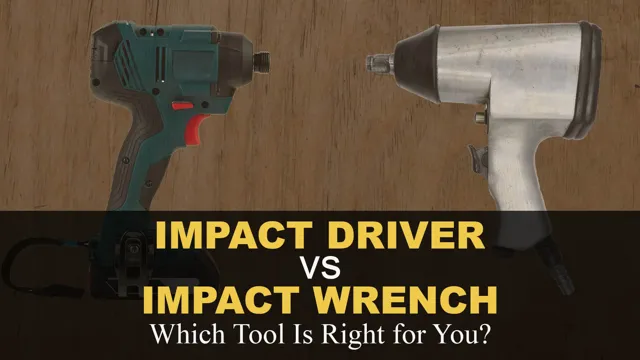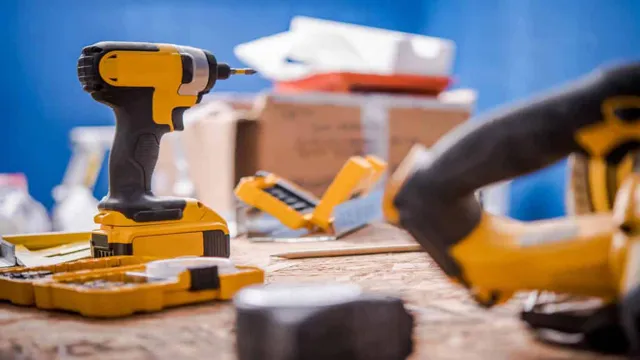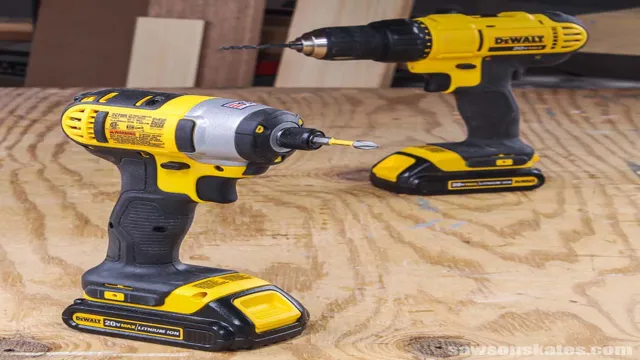Will Impact Driver Drill Into Concrete? Learn How to Drill Efficiently

If you’re considering drilling into concrete, you may be wondering if your trusty impact driver is up for the task. After all, these little machines are powerful and versatile, so it’s only natural to wonder if they can handle tough jobs like drilling into concrete. The short answer is yes, an impact driver can drill into concrete, but there are some important things you need to know before you start drilling.
In this blog post, we’ll cover everything you need to know about using an impact driver to drill into concrete, including what type of bits you need, how to prep the concrete, and some tips for getting the best results. So, whether you’re a seasoned pro or a DIY newbie, read on to learn more about drilling into concrete with an impact driver.
Understanding Impact Drivers
“Will an impact driver drill into concrete?” This is a common question from DIY enthusiasts and professionals alike. The truth is, an impact driver can certainly drill into concrete, but it all depends on the type and thickness of the concrete you’re working with. For thinner slabs or walls, a good quality impact driver should be able to handle the job with the right kind of masonry bit.
However, for thicker or reinforced concrete, you may need to use a specialized hammer drill or rotary hammer to get the job done. It’s important to use the right tool for the job to ensure safety and efficiency, so always do your research before starting any project involving concrete.
What are impact drivers?
Impact drivers have become a popular power tool in recent years, especially among DIY enthusiasts and professionals in the construction industry. They are handheld tools that deliver bursts of high torque and rotational force, making them ideal for driving screws, bolts, and other fasteners into hard surfaces. Compared to traditional drills, impact drivers are more compact, lightweight, and efficient, and they are also less prone to stripping screws or damaging materials.
They work by combining a hexagonal shank that fits snugly into the fastener with a fast-acting rotational hammering mechanism that delivers rapid bursts of rotational force. This helps the driver generate high torque even when working with hard, dense materials like concrete or hardwood. Whether you’re working on a home improvement project or a construction site, an impact driver can help you get the job done quickly and effectively, saving you time and effort in the process.

How do impact drivers work?
Impact drivers have revolutionized the world of DIY and construction projects. They have become increasingly popular because of their efficiency, power and precision. Unlike regular drills, impact drivers work by using rotational force and concussive blows to drive screws into tough materials.
The driver’s motor produces a rotational force and, once the screw comes into contact with the material, a spring-loaded mechanism activates. This mechanism transfers the torque to an internal anvil, which delivers a series of high torque, high-speed impacts to the screw. This action enables it to penetrate the surface quickly, even in dense wood or metal.
This means that the screw won’t get stuck and the user can work more efficiently, saving time and energy. Overall, impact drivers are game-changers in the construction world, making tasks easier and more precise.
Drilling into Concrete with an Impact Driver
If you’re wondering whether an impact driver can drill into concrete, the answer is yes, but with some limitations. While impact drivers are designed for fastening screws and bolts, they can also drill smaller holes in masonry surfaces, including concrete. However, the size of the hole and the type of drill bit you use will impact ease of drilling and the success of your project.
Impact drivers are best suited for small DIY projects, such as hanging picture frames, putting up shelves, or drilling pilot holes for anchors. For larger projects, like drilling deeper holes for anchor bolts, you may want to consider investing in a hammer drill for efficient and accurate results. Regardless of the tool you choose, always wear safety equipment, including eye protection and a dust mask, when working with concrete to avoid health risks.
Impact driver vs. conventional drill
If you’re planning on drilling into concrete, you might be wondering if an impact driver or a conventional drill is the better option. While both can technically get the job done, an impact driver is the more efficient tool. This is because an impact driver uses a combination of rotational force and concussive strikes to power through tough materials.
When used with masonry bits, an impact driver can quickly and easily break through concrete. Conventional drills, on the other hand, rely solely on rotational force, which makes them slower and less effective in tougher materials like concrete. So if you’re looking for a tool that can make drilling into concrete easier and faster, an impact driver is the way to go.
What kind of drill bits should you use?
When it comes to drilling into concrete, using an impact driver can make the job easier and quicker. But what kind of drill bits should you use? The answer is simple – you need ones specifically designed for concrete. These bits are made with a carbide tip that can withstand the hardness and density of concrete.
They also have a different shape than regular drill bits; they are rounder and have a wider flute, which helps to remove debris as you drill. Using the wrong type of bit can cause excessive wear and tear on your impact driver, as well as cause damage to the bit and the concrete surface you’re drilling into. It’s crucial to invest in high-quality concrete drill bits to ensure a clean, efficient, and effective job.
Don’t take shortcuts when it comes to your tools and equipment – use the right bit for the job and you’ll see better results in less time.
What type of concrete is suitable for impact driver drilling?
When it comes to drilling into concrete with an impact driver, it’s important to choose the right type of concrete for the job. Generally, the best option is a high-strength concrete that is designed to handle the impact and force of drilling without cracking or breaking. This type of concrete is made from a mixture of cement, water, and aggregates, and is typically used in commercial and industrial construction projects.
However, if you’re working on a smaller project, you can also use a standard concrete mix that is designed for general purpose applications. It’s important to note that no matter what type of concrete you use, you will still need to use the right drill bit and technique to ensure accurate and efficient results. With the right tools and a little bit of know-how, you can achieve great results when drilling into concrete with an impact driver.
Tips for Effective Drilling with an Impact Driver
If you’re wondering whether an impact driver can drill into concrete, the answer is a resounding yes! However, to achieve the best results, there are a few things you’ll need to keep in mind. Firstly, you’ll need to select the right type of drill bit. Tungsten carbide bits are typically the most effective for concrete drilling, but masonry bits can also work in a pinch.
Secondly, you’ll want to ensure you’re using the right technique. Unlike traditional drills, an impact driver uses rapid bursts of force to create impact. This means that you’ll want to use a slow and steady motion to avoid the risk of damaging the bit or the driver.
Finally, it’s worth noting that drilling into concrete can be tough on both your drill and your body. It’s therefore recommended that you take frequent breaks to avoid wrist and hand fatigue. By following these tips, you’ll be well on your way to drilling into concrete effectively with your impact driver.
Choose the right impact driver and drill bit
Drilling with an impact driver can make your DIY projects much easier and efficient. However, to achieve the best results, it is essential to choose the right impact driver and drill bit. Firstly, you should select an impact driver that has a high torque output to provide enough power for the toughest materials.
Secondly, consider the right drill bit that matches the type of material you’re drilling. For instance, if you’re drilling through concrete, you need a masonry bit; if you’re drilling through hardwood, a spade bit will do the job. Additionally, remember to maintain a firm grip on the impact driver to avoid slipping, and keep the bit perpendicular to the surface to prevent damaging the material.
These simple tips will help you achieve precise and efficient drilling with an impact driver, saving you time and effort.
Pre-drilling and dust removal
Pre-drilling and dust removal are crucial steps for effective drilling with an impact driver. Pre-drilling is the process of creating a small guide hole in your material that helps to reduce the chance of your material splitting. By pre-drilling, you’ll ensure that the hole you want to drill is accurate and precise.
You can also use your pre-drilled hole as a reference point for your impact driver’s tip to prevent it from wandering off course. Another important step is dust removal. Drilling creates a lot of dust, and if this dust is not removed, it can clog up the hole and even cause your drill bit to overheat.
Using a dust removal system, such as a vacuum cleaner or a dust extractor, is advised to ensure that the hole is clear and your tools will function properly. By taking these two simple steps, you’ll ensure that your drilling experience with your impact driver is efficient and hassle-free.
Conclusion
In conclusion, when it comes to the task of drilling into concrete, the impact driver is your best friend. With its powerful bursts of impact energy, it can effortlessly break through even the toughest of surfaces, making your job faster and easier. So the next time you’re facing a concrete drilling project, don’t hesitate to pick up an impact driver and watch as it effortlessly conquers those stubborn surfaces.
Just don’t forget to wear your safety goggles!”
FAQs
What is a hammer drill and how is it different from a regular drill?
A hammer drill has a hammering function that helps it to drill into harder materials like concrete, whereas a regular drill does not.
Can I use a regular drill to drill into concrete?
It is possible to use a regular drill to drill into concrete, but it will take much longer and may not be as effective as using a hammer drill.
What size of hammer drill should I use for drilling into concrete?
The size of the hammer drill you need will depend on the size of the hole you need to drill and the depth required. It is best to consult the manufacturer’s guidelines or a professional for guidance.
What type of drill bit do I need for drilling into concrete?
A masonry drill bit made of tungsten carbide is the best choice for drilling into concrete.
How can I ensure that I drill into concrete accurately without damaging surrounding areas?
Use a laser level to mark the spot accurately before drilling, and use a depth stop on the drill bit to prevent drilling too deeply.
Can I use water to cool the drill bit while drilling into concrete?
Yes, using water to cool the drill bit while drilling into concrete can help prevent overheating and prolong the life of the drill bit.
How can I reduce the noise levels when using a hammer drill for concrete drilling?
Using ear protection is strongly recommended when using a hammer drill. Additionally, using a good quality drill bit and maintaining the drill properly can help reduce the noise levels.



